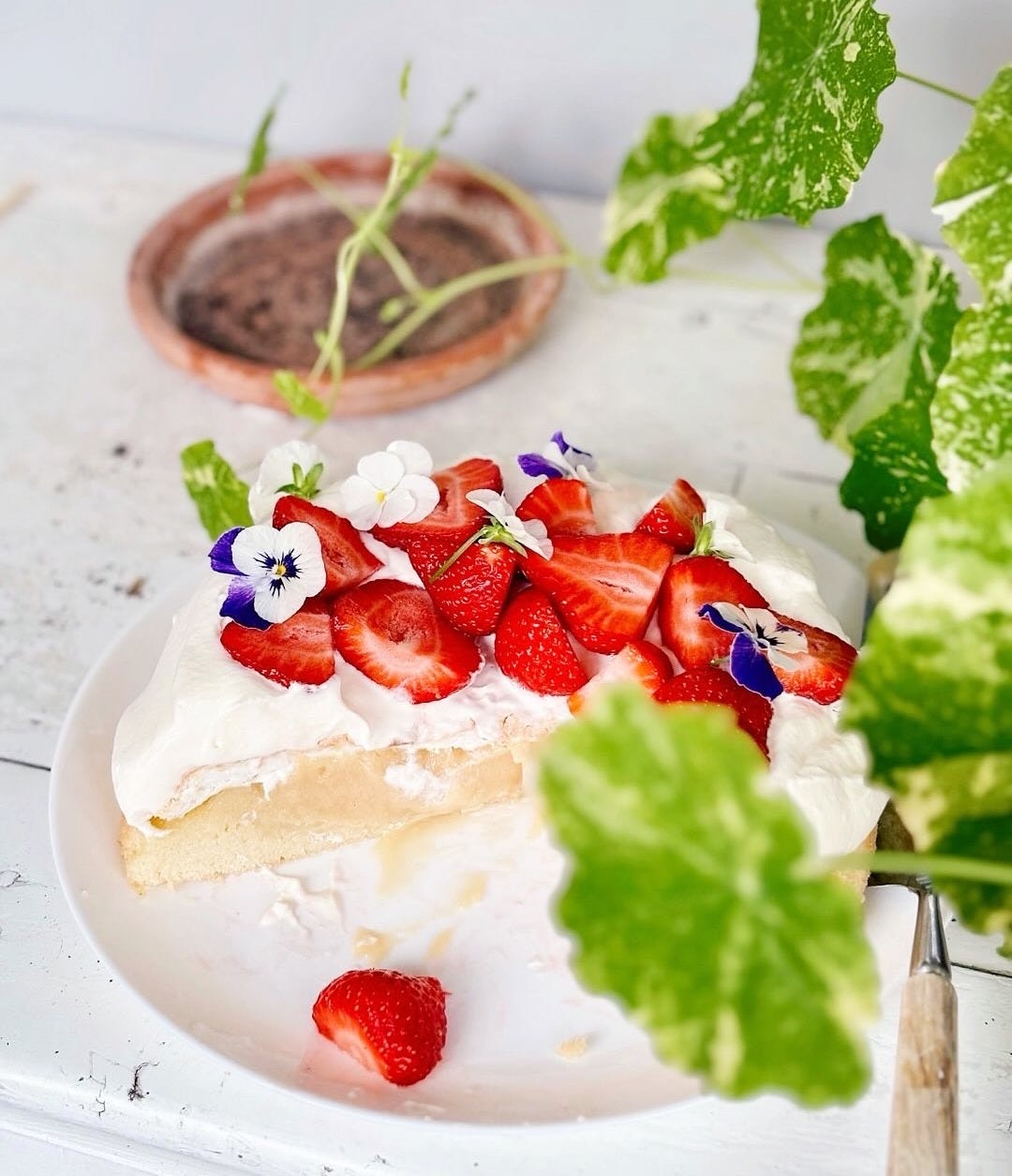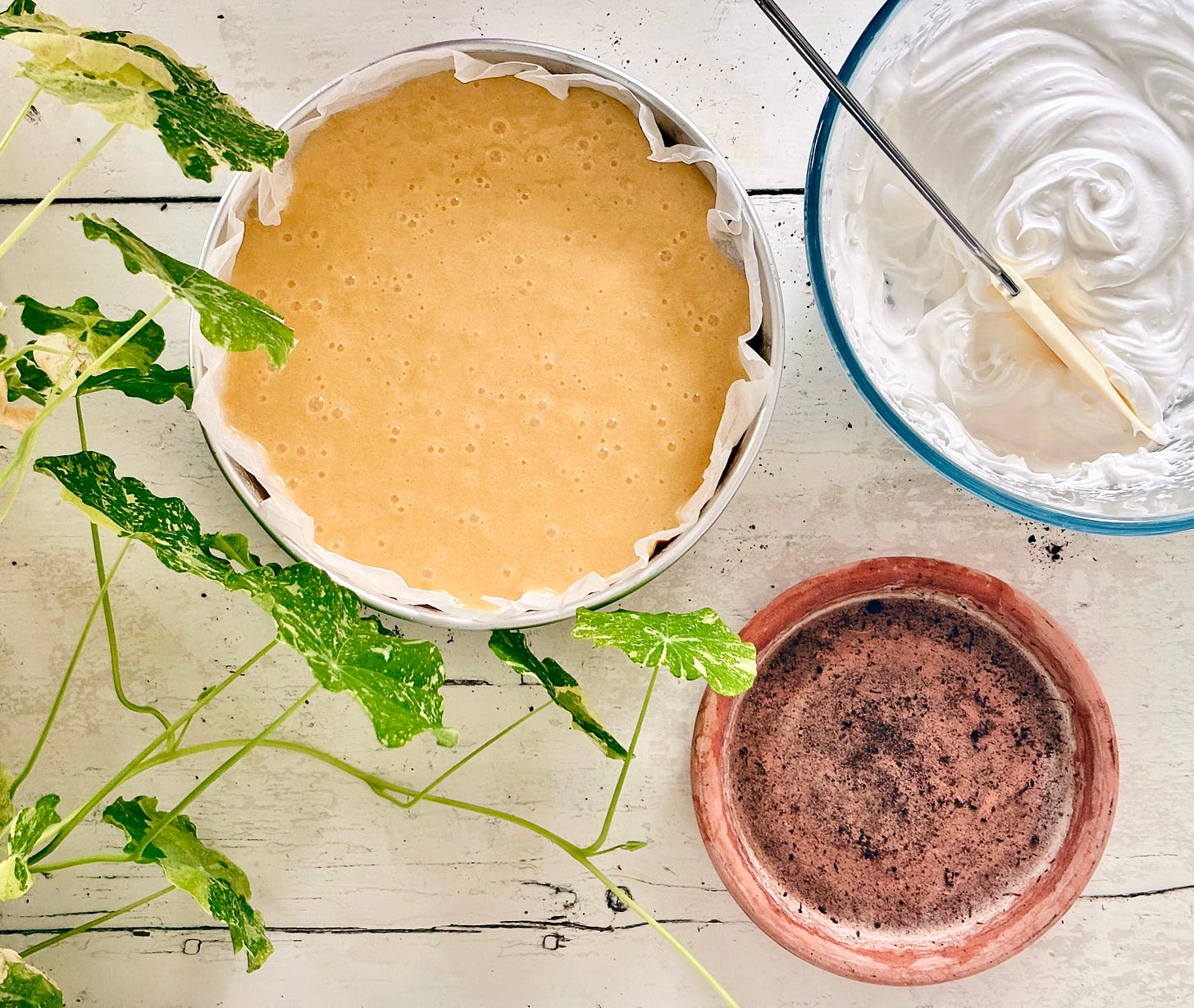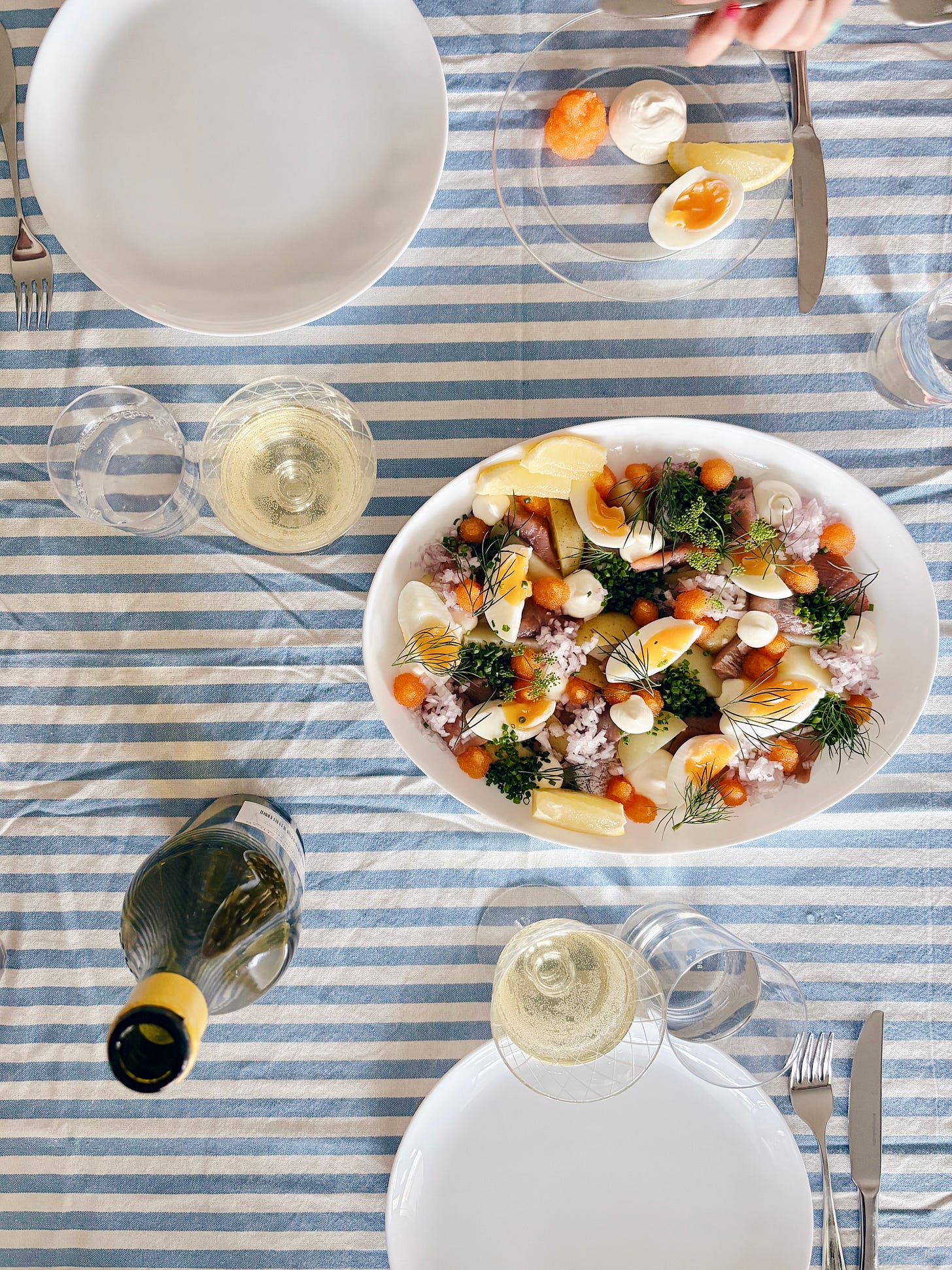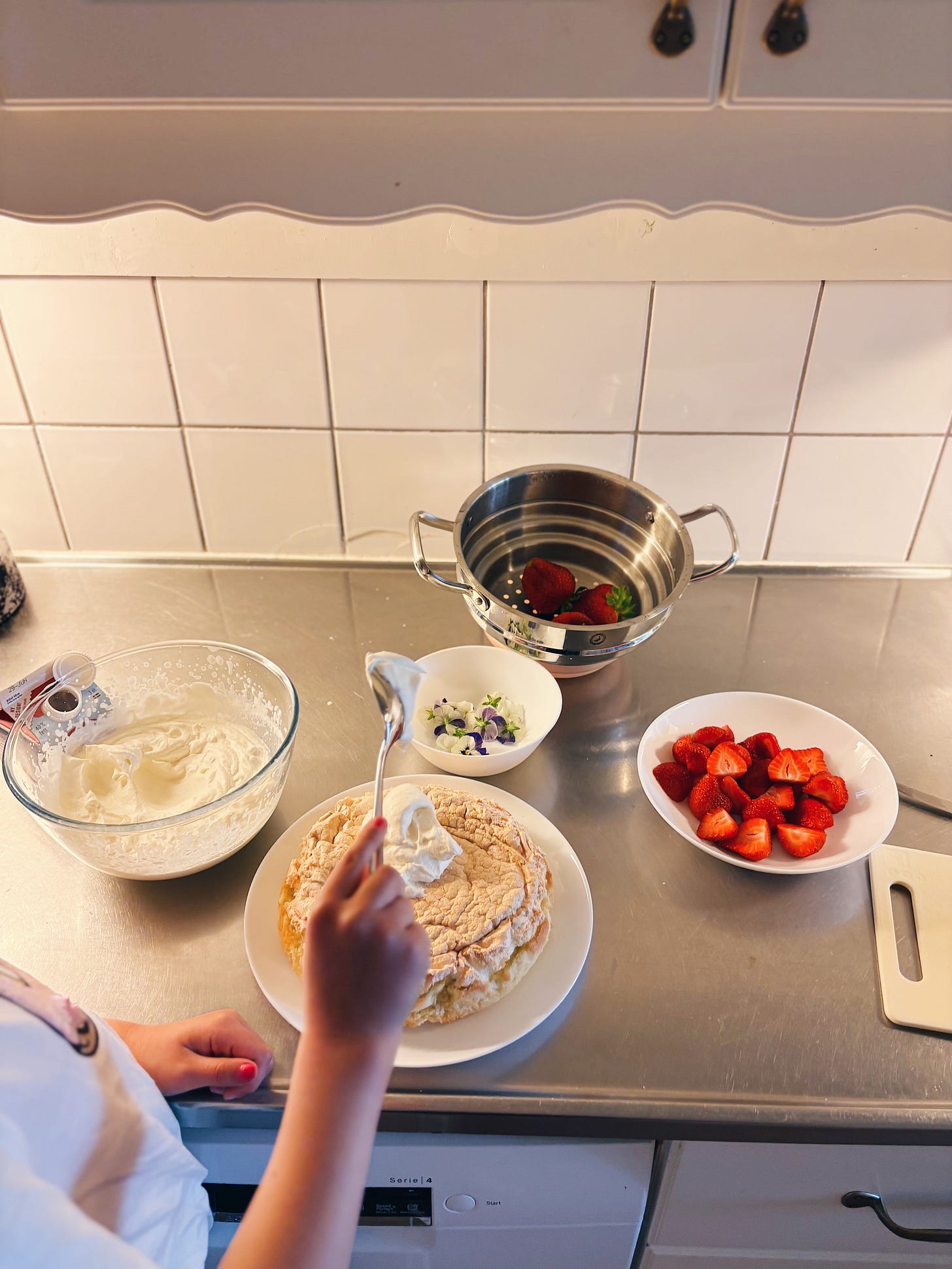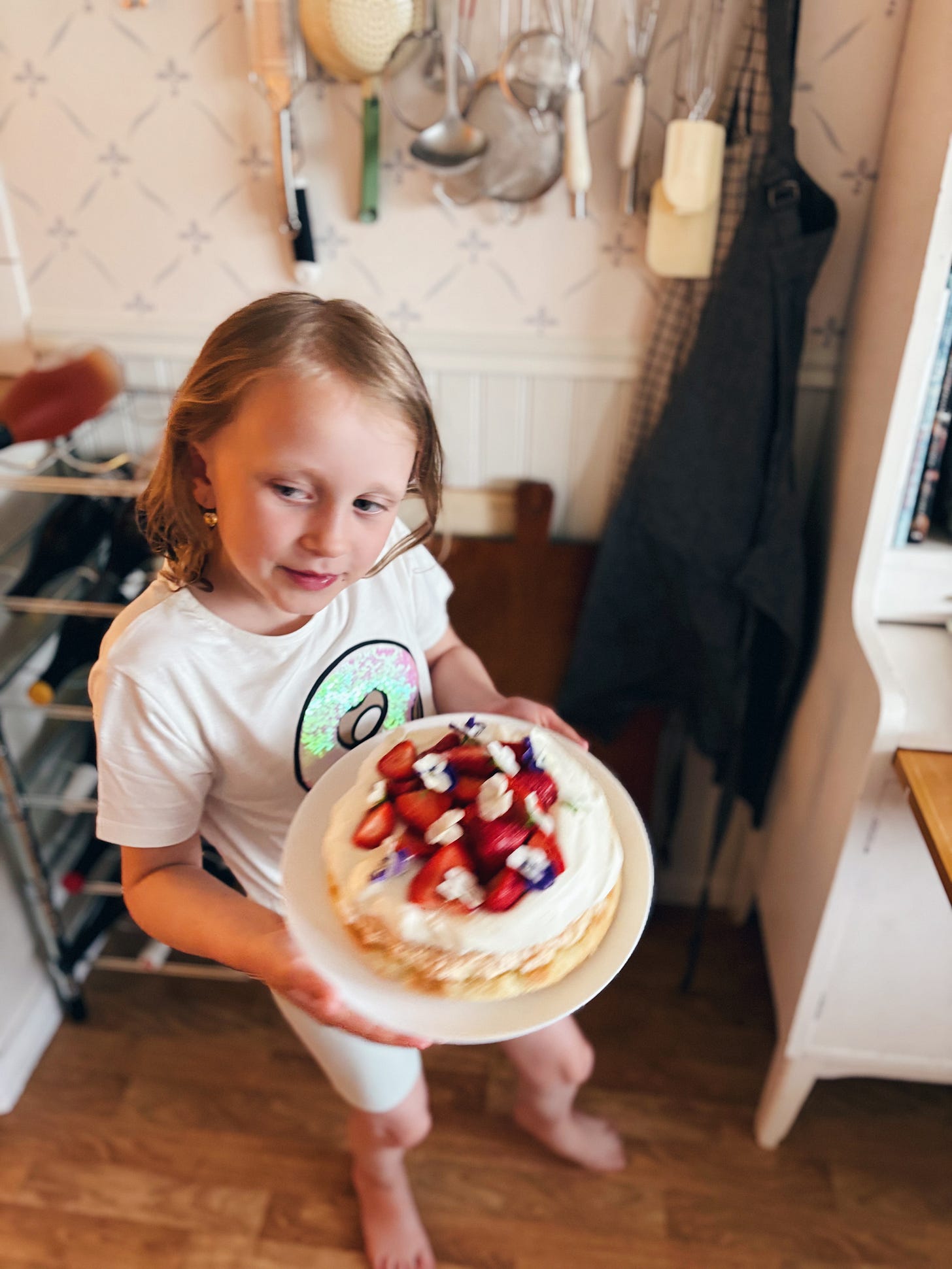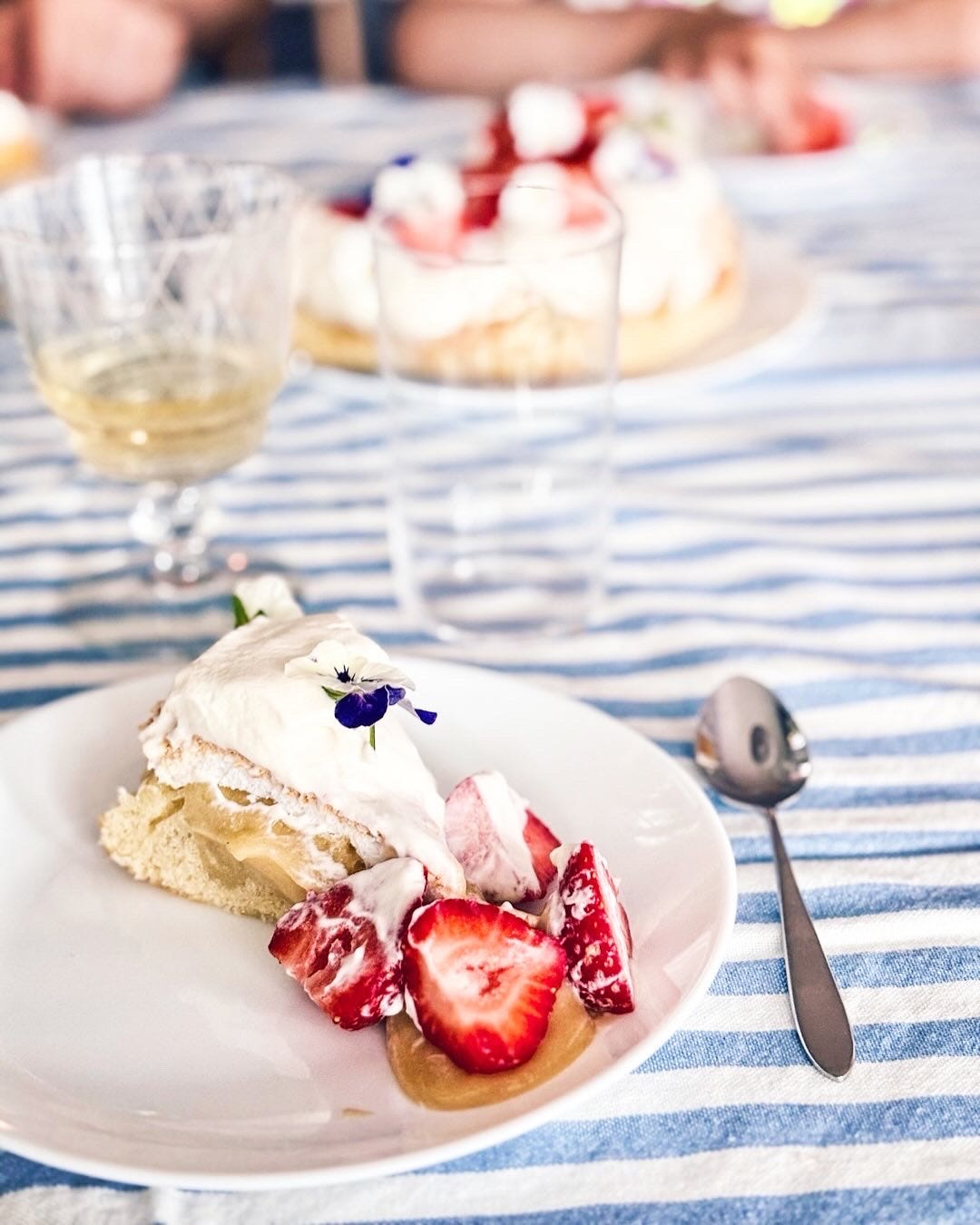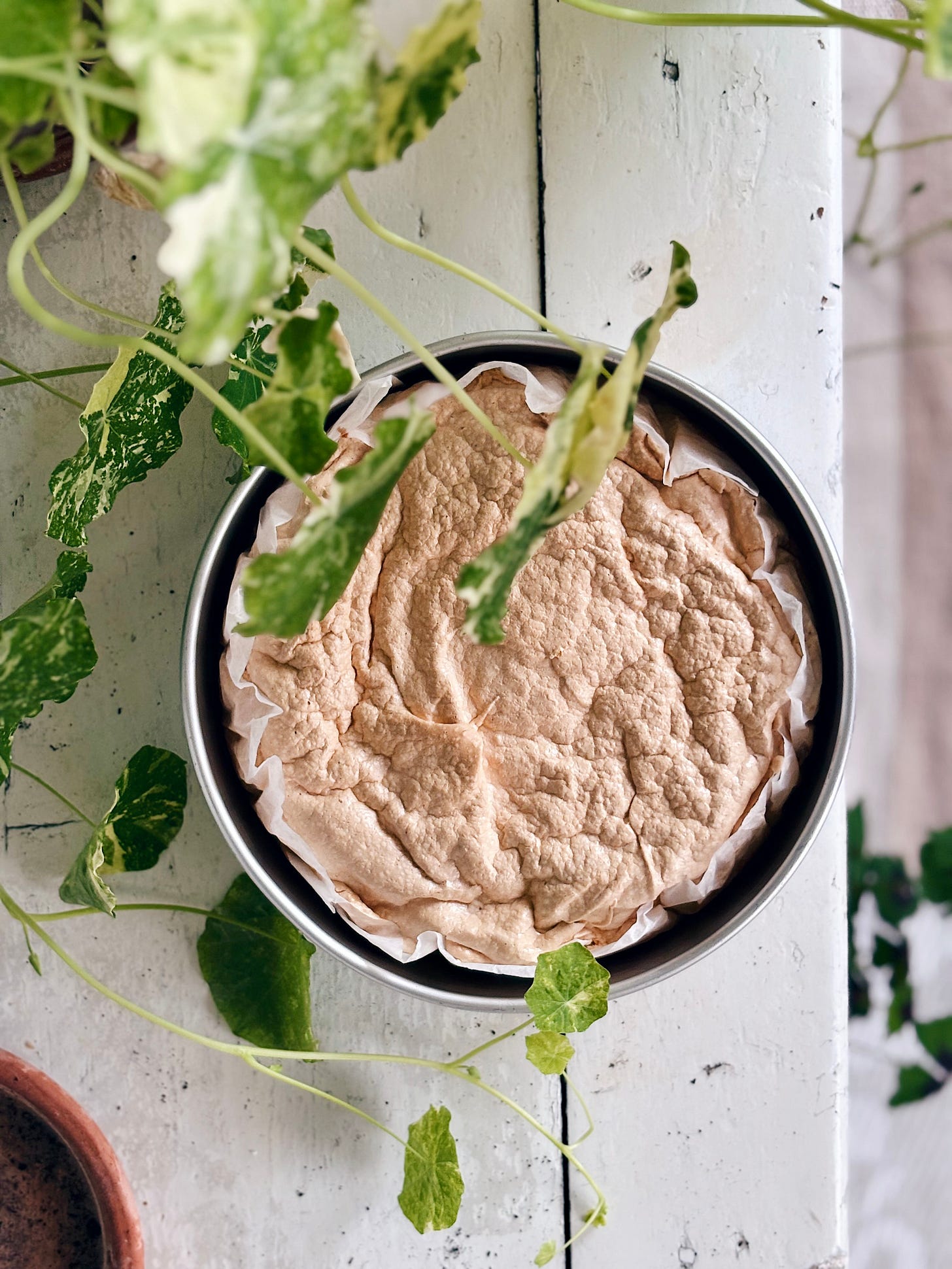Pinocchio kladdkaka
On a meringue-topped Swedish gooey cake, midsummer crowns & learning to love matjessill
Welcome to The Bakers’ Cottage, a newsletter about baking, stories, and the rhythm of life in the north. If you’re new here, thank you for joining. If you’ve been reading for a while – I’m so glad to have you back.
The post is a little long for email – if it cuts off, you can read the rest on the website or in the app.
I hope you enjoy this small, slightly sticky adventure.
It starts with kladdkaka. And Pinocchiotårta. And with a memory that isn’t quite mine, but stayed with me.
In Sweden, there’s kladdkaka – a gooey, underbaked chocolate cake that goes from cupboard to oven in less than ten minutes. It’s made from eggs, sugar, butter, cocoa, and flour, whisked together in a single bowl – or, as I do, in the pan I melt the butter in – and baked until the edges just begin to settle.
It’s one of my favourite Swedish recipes, and perhaps the one my kitchen sees the most. I love it in late summer, with a generous pour of vaniljsås and bilberries stirred with just a little sugar.
Then there’s Pinocchiotårta – a summer classic made with a light sponge base, topped with whipped egg whites and flaked almonds, and baked until the meringue turns golden and crisp. It’s often served with berries and cream, and seems to appear at every Swedish celebration once the rhubarb fades and the strawberries come in.
It was Judith who told me about her grandmother’s version – how she used to underbake the cake on purpose, so the meringue would sink slightly into the sponge, and the centre stayed soft. “It was the best thing I knew,” Judith said, and I believed her, completely.
I kept thinking about that story – not just the cake, but the memory of it – long after the conversation ended.
It came back to me again one evening as I was baking three full gastro pans of Pinocchiotårta for a function at the restaurant. The kitchen was warm, the air smelled of sugar and toasted almonds, and I thought – what if I made one for midsommar? Not the sponge version, but something closer to a vanilla kladdkaka. Something that stayed runny in the middle, with that same golden, crackled top.
I baked it the night before Midsummer’s Eve.
Before I began, I looked around to see if anyone else had tried something similar – and there it was: a version by Swedish food writer Camilla Hamid. I’d baked blondies a few times before, but never quite came to a recipe I loved. They always turned out too sweet, or perhaps there was something else wrong with them – I can’t even remember now. Which says a lot about how little they asked to be remembered.
So I thought I’d try Camilla’s recipe. And I did.
The cake baked up golden, the meringue puffed dramatically before falling and crackling across the top. I let it cool, then tucked it into the fridge overnight to firm up.
The next morning, I went straight outside. The air was chilly for late June – not like last year. I wrapped my hands around a cup of coffee and sat for a while, watching the light shift through the pines.
Later, Sienna and K joined me. We picked flowers and made midsummer crowns at the garden table. Sienna tucked red clovers between the daisies and aspen leaves. K brought out breakfast – thick slices of bread with salami, cucumber, and salad leaves from the raised beds. And a yoghurt and caraway dressing I’d stirred together.
In the afternoon, we headed to Bonnstan – Skellefteå’s old church town, a cluster of small wooden cottages that once hosted families on overnight visits for Sunday services. These days, it comes alive in the summer, especially at midsommar.
We danced around the midsommarstång, hand in hand with strangers, pretending to be frogs and singing songs that end in laughter. Then we climbed aboard a miniature train, riding from the square to the church and back, and wandered through the narrow lanes.
The sky hung low and grey, but Sienna was bright in pink – sticky from the lollipop we’d bought at the market stand.

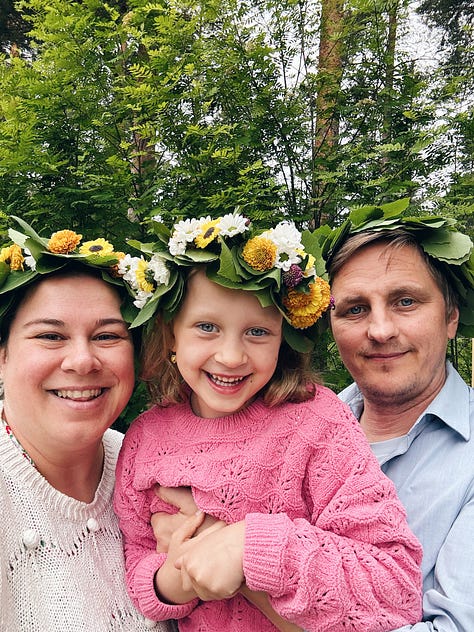
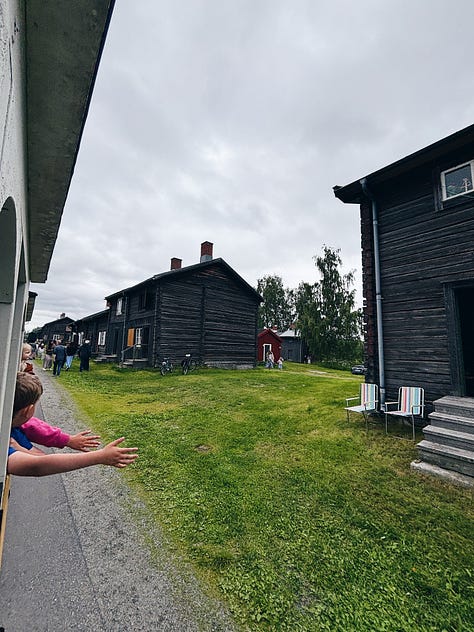
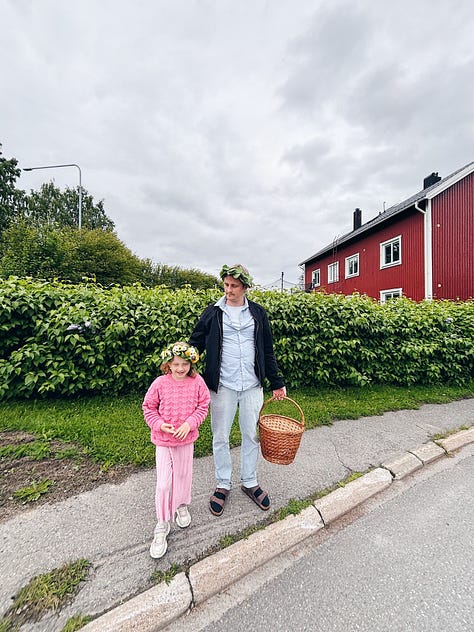
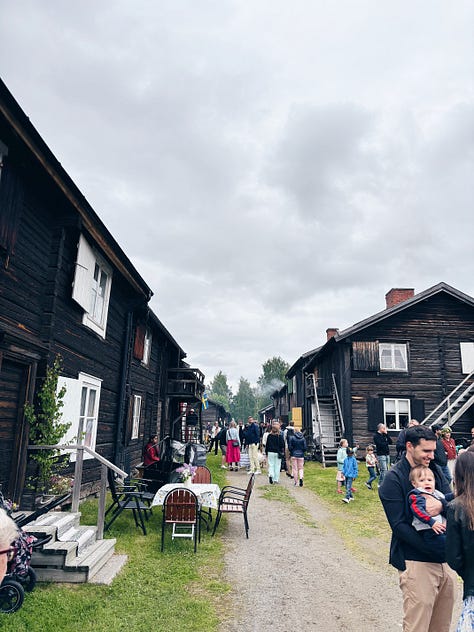
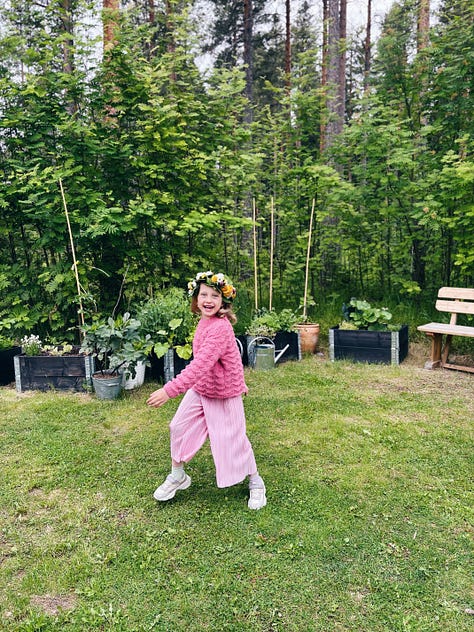
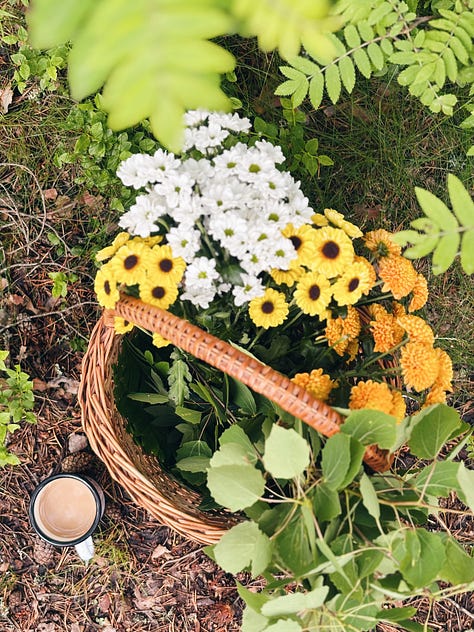

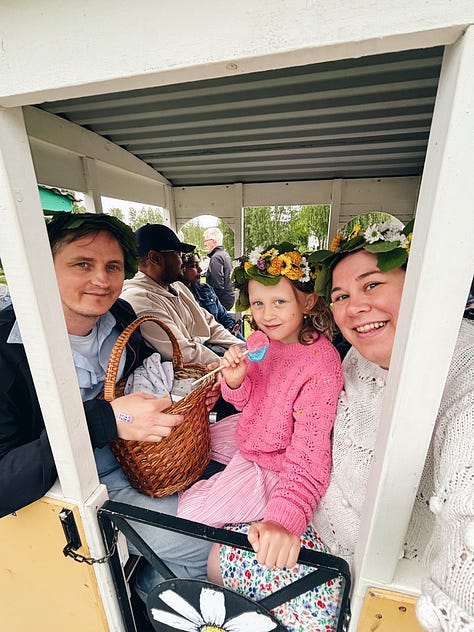
Back home, we boiled new potatoes in salted water until their skins just began to split. We served them warm with crème fraîche, Kalix löjrom, finely chopped shallots and chives, and seven-minute eggs with yolks the colour of buttercups.
There was matjessill too – sweet-spiced herring cured in a dark brine with clove, allspice, and a touch of cinnamon. We ate it on crisp squares of tunnbröd, with a spoonful of melted brown-butter drizzled on top.
I wasn’t so fond of matjessill when we first moved here, ten years ago. Its flavour felt too bold, too sharp, too much. But something has shifted. Maybe it’s the way traditions repeat themselves until they settle inside you. These days, I find myself craving it – that anchoring mix of salt and spice and sea. Especially in early summer, when everything else tastes green and new.
For dessert, we had the Pinocchiotårta I’d baked the night before. I took it out of the fridge while Sienna whipped the cream, then went to pick a few pansies from the garden. I hulled the strawberries and sliced them into a bowl.
We served the cake topped with a mountain of softly whipped cream and a handful of berries.
When we sliced into it, the centre was runny – like cake batter held together by will alone. The meringue was crisp at the edges, chewy underneath. The cream melted into it. Oddly good.
I wasn’t sure I liked the texture of the edges – too dry, maybe – but I found myself going back for more anyway.
K and Sienna loved it. And though I’m still not sure I did, I think I’d make it again – just to find out. Perhaps you will too. Bake it at home and see what you think. Yes, maybe there’s room in the world for white kladdkaka after all!
Pinocchio kladdkaka
This is the recipe I made the night before Midsummer’s Eve – adapted from Camilla Hamid’s version of Pinocchiotårta. The base is a pale vanilla kladdkaka, and the topping a golden meringue.
Camilla serves hers cold from the fridge, but I found I like it best just cooled to room temperature – topped with plenty of ice-cold whipped cream and fresh strawberries.
Notes
On salted butter
If you’d asked me years ago about my thoughts on salted butter, I might have given a plain: Non!
But after living in Sweden for the past ten years, I now bake exclusively with salted butter – and honestly, I’m never going back. That said, I have to admit it makes writing recipes a bit trickier, as the salt content in butter varies widely across the globe. Here in Sweden, it’s typically 1.2%.
Tip: If using unsalted butter, just add a little extra salt and adjust to taste.
On vanilla sugar
Vanilla sugar is a staple in many French and Swedish homes, but a teaspoon of vanilla extract or vanilla bean paste will work just as well.
If you’d like to make your own vanilla sugar, it’s simple. I always collect used vanilla pods, wash them if needed, and leave them to dry in an open glass jar in my skafferi [pantry] until crisp. Then, I grind 3 dried pods with 300 g caster sugar into a fine powder and store it in an airtight container.
On whipped cream
Use a 40% fat whipping cream, unsweetened and whipped to soft peaks. It will melt into the meringue and the cake batter underneath, making for the most satisfying gooey spoonful.
MAKES one 20cm cake, serving 6–8 people
For the kladdkaka base
170 g salted butter
200 g caster sugar
1 tbsp vanilla sugar (or 2 tsp vanilla extract)
3 eggs (around 150 g)
155 g plain flour
A generous pinch of fine sea salt
For the meringue topping
2 egg whites (around 60 g)
A generous pinch of fine sea salt
90 g caster sugar
To serve
250 g whipping cream
400 g fresh strawberries, hulled and sliced in half
Prepare the base
Preheat the oven to 175°C / fan 150°C. Butter and line a 20 cm cake tin with parchment.
Melt the butter in a saucepan. Remove from the heat. Stir in the sugar and vanilla.
Add the eggs one at a time, whisking until smooth.
Fold in the flour and salt until just combined. Pour the batter into the prepared tin and set aside.
Make the meringue.
In a bowl, whisk the egg whites and salt to soft peaks. Gradually add the sugar and whisk until stiff and glossy.
Spoon the meringue over the batter, smoothing gently with a spatula. Scatter with flaked almonds.
Bake for 30–35 minutes, or until the meringue is golden and the edges are just set. The centre should still wobble.
Cool completely, then refrigerate for one to two hours – or until just cold to the touch.
Top and serve
Whip the cream until soft. Spread or pipe it over the kladdkaka. Top with hulled strawberries and serve in wedges.




